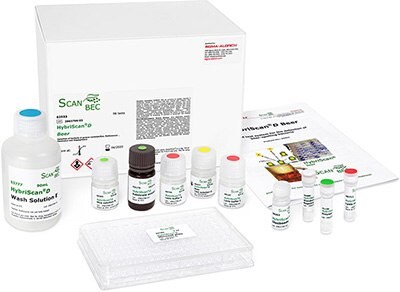HybriScan® Rapid Microbial Test System
Rapid Microbiological Method: Sandwich Hybridization
The method simply needs a centrifuge, a thermal mixer and an optional a microplate reader. The complete analysis can be achieved in 2 hours for the HybriScan®D kit (quantitative kits) and about 1 hour for HybriScan®I kit (identification kits). Qualitative results can be determined by eye or, for quantitative measurement, use with a microplate reader.

Figure 1.HybriScan® system screening workflow with analysis time of approx. 2–2.5 hours
Sensitivity, Specificity and Flexibility of Sandwich Hybridization
Sandwich hybridization is very sensitive and can detect attomoles of the target rRNA molecules in yeast or bacteria.1-3 These types of cells contain a large number of rRNA-containing ribosomes; a single cell therefore contains several thousand copies of rRNA but only one DNA copy. Sandwich hybridization provides sensitivity in crude biological samples because it is not susceptible to matrix interference. By using specific probes, the HybriScan® system allows both genus or species-specific detection and it is therefore applicable to many analytical fields, including monitoring the microbial content of beer, wine, non-alcoholic beverages, drinking water, a wide variety of foods and wastewater.
- Detects viable microorganisms only—minimizes false-positive results from dead bacteria
- Not sensitive to sample matrix
- Genus- and species-specific detection
- Results in just 2 hours after enrichment
- Broad application range: beer, wine, non-alcoholic beverages, drinking water, food and wastewater
Advantages of HybriScan® technology over other microbial detection techniques |
|---|

Figure 2.HybriScan® technology
HybriScan® Waste Water Bacterial Count Calculator
For our Wastewater Kits (04447 HybriScan® D Waste Water Microthrix parvicella, 78436 HybriScan® D Waste Water Total Bacterial Count), we provide an excel sheet (below) for calculation of total bacterial count, Microthrix count, and ratio of Microthrix: Total Bacterial Count.
References
To continue reading please sign in or create an account.
Don't Have An Account?